#Cell Fusion Experiment
Explore tagged Tumblr posts
Text

The significance of Hojo training/testing Sephiroth’s combat ability, as well as Sephiroth’s statement in chapter 1:

….cannot be understated. Hojo does not engage with the other SOLDIERs, not even Hollander’s “second-rate” projects. This means that to test the limits of SOLDIER’s abilities, only Sephiroth would be a worthy candidate.
I am writing a long post on it, but the hint that Sephiroth was indeed Hojo’s favorite lab rat for testing the limits of SOLDIER is a confirmation of ancient fanon, if true.
Zack experiences hints of what Sephiroth was likely raised doing in Crisis Core, when the player chooses to complete quests for Hojo.

These quests include the disposal of monsters in the lab cells, testing combat ability against extremely dangerous specimens, and painful physical enhancement inside Hojo’s famous fusion pod.
(I will go into detail in my other post, but if these hints are intentional, my theory on why Sephiroth has a visceral, violent reaction and immediate willingness to associate the mako-infused humans inside the Nibelheim reactor pods with his own self and creation could end up being bolstered. This would also explain his sudden pain and memory in the Halloween event).

While some of the experiments of Hojo are portrayed as almost funny because of Zack’s light-hearted (but naive) enthusiasm and his unusual level of endurance, there is something disturbing in the implications of how Hojo conducted his research on SOLDIER combat ability. Most likely all on Sephiroth.

”Sephiroth, next test. I want to see your fighting strength when working in a team.”
It becomes more disturbing knowing that there was no consent from a child raised by Shinra to be their strongest warrior and put in the public eye. It’s similar to Deepground, but in this case, the child was somehow told or taught to not speak of the unethical manner in which he was raised.
How did Shinra achieve this so flawlessly? And will Sephiroth find a way to share his experiences with Angeal, who was in a small way, with him in spirit at one time?

#final fantasy 7#ffvii#ff7#ever crisis#the first soldier#crisis core#sephiroth#angeal hewley#professor hojo#my translations
174 notes
·
View notes
Note
Hello, after rotating this child in my brain I have decided to revise/update one of my headcanons
(CW for mentions of child abandonment + attempted murder, and also lab experiment + doctor shenanigans, medical malpractice maybe ??? c00lkidd has been through the horrors sorry about that)
c00lkidd was born from an experiment, specifically how robloxian dna and drakobloxxer dna could mix into a singular organism . basically, the scientists mixed some cells together and put the homunculus in an egg to see what would come out
the experiment was partially successful at first ! c00lkidd was alive and well, just horrible skin due to the dna fusion not knowing how to combine the robloxian skin and drakobloxxer scales
the scientists tried to solve the skin problem with treatments and surgical procedures, but nothing worked. so they then deemed the experiment as a whole unsuccessful. Because this weird mix between species didn’t really count as any animal in the humane treatment system thing to them, they just packed it up in a box and sent it anonymously to the only person they suspected would deal with it: a deadly exploiter whom had no mercy towards anyone. Little did they know,
extra stuff:
Bluudud is a sea monster ! particularly a sorta mix between a shark and a seal . Super hard to explain the specifics without drawing it out though, so I’ll probably send a doodle of it one day
I have known prettyprincess for only like a week I still don’t know how to spell her name help!!!!!! she’s a bird to me, some sort of corvid specifically, loves shiny things like tiaras and gems
-c00l anon
This is the second time I've read a hc about 007n7 getting c00lkidd because others sent the kid to him thinking he would 'take care of it'. And I think should start killing those senders.
I'm in love with sea monster Bluudud. He's water and sea themed as a parallel to c00lkidd having fire abilities!! And bird pr3ttypriincess,,, She'd totally have a little horde of anything shiny or pretty she finds
#forsaken headcanons#roblox forsaken#forsaken roblox#forsaken#tw child abandonment#tw medical malpractice#c00l anon#c00lkidd forsaken#007n7 forsaken#bluudud forsaken#pr3ttypriincess forsaken#mod taph 💥
70 notes
·
View notes
Text
Also preserved in our archive
Hey! Look! A great breakdown of that thing I'm always talking about being a big yet entirely-overlooked deal by 90% of medical professionals in regards to this particular virus!
SARS-CoV-2, the virus behind COVID-19, is not done with us. Over the past four years, it has shown a remarkable ability to adapt, with each new variant outmaneuvering our immune systems in unique ways. The recently published study on the XEC variant (November 22, 2024) provides fresh insights into how this virus is evolving. (1) Combining this with the broader history of immune evasion, we see a troubling pattern: the virus continues to find ways to evade the immune system and in many cases, persist, potentially leaving lasting impacts on our health even for those who experience only mild or asymptomatic infections.
What the Study Found: XEC’s Immune Escape Arsenal The latest study revealed that the XEC variant—an offspring of two previous variants, KS.1.1 and KP.3.3—has developed mechanisms that make it harder for our immune systems to neutralize it. Here’s how it works:
1. Glycosylation Mutations in the N-terminal Domain (NTD):
The XEC variant introduces new glycosylation sites, such as the T22N mutation, which act like a cloak, hiding key parts of the virus from antibodies.
These sugar molecules shield the receptor-binding domain (RBD), a crucial target for vaccines and natural immunity, making it harder for antibodies to bind and neutralize the virus.
2. Allosteric Effects:
Mutations in the NTD don’t just shield the virus—they also alter the behavior of the RBD through a process called allostery. These changes can make the RBD less accessible or alter how it interacts with human cells, further reducing the effectiveness of antibodies.
3. Potential Impact on Membrane Fusion:
The study hints that these mutations may also enhance how efficiently the virus fuses with human cells, potentially increasing its infectivity.
Immune Evasion: A Constant Tug-of-War The ability of SARS-CoV-2 to adapt is not new. Looking back at the history of immune evasion, we see a pattern:
The Early Days: Mutations like D614G made the virus more infectious.
Alpha and Beta Variants: N501Y and E484K mutations increased binding to human cells and evasion of neutralizing antibodies.
Omicron Era: A flurry of spike protein mutations allowed the virus to reinfect people with previous immunity and bypass vaccine-induced protection.
XEC is the next chapter in this story, combining these strategies with new tricks like glycosylation and allosteric modulation to stay ahead of human defenses.
Why This Matters: Beyond Infections Understanding immune evasion isn’t just about tracking infections—it’s about long-term health impacts. Here’s why this evolution is particularly concerning:
1. The Shadow of Long COVID:
Millions of people suffer from Long COVID, characterized by fatigue, brain fog, heart palpitations, and muscle pain. The virus’s ability to persist and evade the immune system might explain why symptoms linger for months or years in some individuals.
Chronic immune activation or hidden reservoirs of the virus could drive these long-term effects.
2. Asymptomatic but Chronic Damage:
Even in people without noticeable symptoms, SARS-CoV-2 has been shown to cause subtle, potentially long-term damage to:
Vascular systems: Leading to inflammation and microclot formation.
Neurological function: Disrupting brain activity and potentially accelerating neurodegenerative conditions. Early onset dementia
Musculoskeletal health: Causing unexplained weakness or pain.
Cognitive performance: Contributing to memory issues and reduced mental clarity. Are you or someone you know having more trouble finding words to use or losing things more often?
3. Vaccines Alone Aren’t Enough:
While vaccines remain essential, their effectiveness is limited by the virus’s rapid evolution. Variants like XEC show how SARS-CoV-2 can sidestep even the most advanced immune defenses, highlighting the need for next-generation vaccines targeting broader parts of the virus. We have know this for a long time now so where are the broader targeting vaccines?
The Future of SARS-CoV-2 Evolution The virus has already demonstrated its ability to adapt to our immune responses in multiple ways, and there’s no reason to believe it will stop. Here are some possibilities for future adaptation:
Further Refinement of Glycosylation: Adding or modifying sugar molecules could make the virus even more difficult to detect.
Enhanced Membrane Fusion: Mutations that improve how the virus merges with human cells could increase its infectivity.
Host Adaptation: Over time, the virus could become better at hiding within human cells, evading both natural immunity and therapeutic interventions.
Increased Chronicity: The virus might evolve to persist at low levels in the body, leading to ongoing inflammation and long-term health consequences.
What We Can Do: Adapting to the Virus’s Adaptations The XEC variant and others like it remind us that SARS-CoV-2 is still a formidable opponent. Here’s what we can do:
1. Invest in Better Vaccines:
Universal or pan-coronavirus vaccines that target conserved regions of the virus are critical.
2. Improve Diagnostics:
Detecting chronic or asymptomatic infections early could help mitigate long-term health effects.
3. Focus on Treatment:
Antiviral drugs that target different parts of the virus, combined with treatments for inflammation and immune dysregulation, could help reduce the impact of Long COVID.
4. Stay Vigilant:
For individuals, maintaining basic preventive measures during high transmission periods can significantly reduce risks.
Conclusion: Learning from the Virus SARS-CoV-2 is teaching us a harsh lesson about evolution. Its ability to adapt and evade our defenses, from antibodies to T-cells, shows no sign of slowing down. Variants like XEC underscore the importance of continued research, innovation, and public health vigilance. By understanding the virus’s strategies and preparing for its next moves, we can better protect ourselves—not just from acute infections but from the long-term consequences.
Reference:
Enhanced immune evasion of SARS-CoV-2 variants KP.3.1.1 and XEC through N-terminal domain mutations (November 22, 2024)
www.thelancet.com/journals/laninf/article/PIIS1473-3099%2824%2900738-2/fulltext
#mask up#public health#wear a mask#pandemic#covid#covid 19#wear a respirator#still coviding#coronavirus#sars cov 2
118 notes
·
View notes
Note
I so want to know more about the nature of vampire bond as well. Especially on the maker's end. Louis didn't get to open up on it more but I could feel the weight of it.
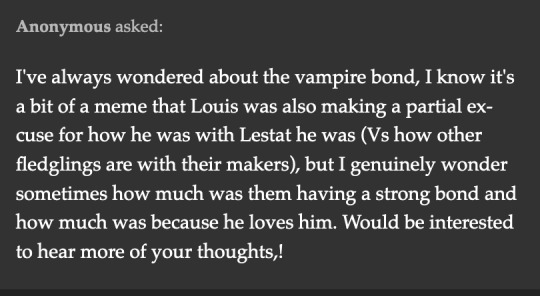
(You guys saw my tags on the gif set, didn't you^^)
Okay, so... the vampire bond.
The vampire bond in the VC is not binding. It does not make slaves out of fledglings. It does not enforce anything.
It does mute the mental connection between maker and fledgling, though Lestat theorizes in later books that they might be simply running interference, because they're too close (in the blood).
A bit of lore:
The vampires in the VC were initially created by a spirit (Amel) fusing with blood (Akasha's). This fusion causes the cells to mutate, that is where the blood hunger comes from. The mutation turns the cells more and more into luracastria, a kind of plastic. That's why their skin goes more pale over time, too, and turns translucent when they're killed and the blood is removed. (But that just as a note)
This spirit, Amel, is like a gigantic web. When a vampire makes a fledgling, they pass on a "tendril" of Amel with their blood. The blood itself already would transform, but since Amel is in the blood...
So that is... the literal "vampire bond".
But... that isn't what Louis is talking about :) Or, I sincerely doubt that is what he talks about^^.
Louis... elevates the "vampire bond" to a status that defies mortal definition. No equivalent.
"It's a bond that can never fully be severed. A bond like that makes you believe there are only two of you on the planet."
True. It can only be severed by death, because of the tendril that connects them. But that is not why he thinks there's only two people on the planet :)
I think Louis used the "vampire bond" for himself as an excuse. As a shield. He held it before his heart, telling himself he felt like that because of it.
But then, why didn't Claudia feel like that? Or Antoinette?
Which brings us to Louis cutting open his veins after Madeleine, and the scene in the restaurant.
The show gave us an extremely beautiful and harrowing little glimpse at the bond there, and I love it, even though it is extremely bitter.
Because by turning Madeleine... Louis realized that the "love" did not come with the turning, nor did his heart beat in sync with hers. He realized that he was now connected to her, yes, but he did not want to be. He did not want to feel the feelings Madeleine felt for Claudia. (And which likely echoed what he and Lestat had shared before!) He did not want to be reminded of what he would never have again. He did not want the connection.
And so he wanted to be rid of it, he opened his veins, in vain, because the tendril... had already been passed on.
The vampire bond is for Louis this mind-altering and literally life-altering experience of being reborn through marrying Lestat. Kissing Lestat on the altar. Meaning it. That is why the floor always feels liquid. That is why their hearts sync up. That is why the emotions coming from Lestat always managed to reach him, and why it felt like it was only the two of them.
It was not the same for Claudia.
That was also something Louis realized there, I bet.
Also.
He likely felt Lestat "die" in 1x07. Just as Lestat... likely felt him suffer and slowly wither when Louis was locked up after the trial.
And Louis felt Madeleine's death.
And he knew Lestat felt Claudia's.
In the VC... and imho in the show... fledglings are made from different intents, which shapes the relationship. I talked about that a bit here. A fledgling, a turning does not equal the "big love"...
But if it does... then it fuses obviously with that love. And elevates the bond to an experience that Louis... obviously does not want to sever. And misses, terribly.
#Anonymous#ask nalyra#amc iwtv#iwtv#amc interview with the vampire#interview with the vampire#lestat de lioncourt#louis de pointe du lac#loustat#vampire bond
124 notes
·
View notes
Text
Random Doctor Who Facts You Might Not Know, Part 62
While looking back on her adventures, an older Susan reflected that by Gallifreyan standards she had just been a baby and that the First Doctor had been an adolescent. (Audio: Here There Be Monsters)
Some Gallifreyans can fly. The Third Doctor took to flying for a while after he learned how to out of a book. (Comic: Levitation)
The Eighth Doctor has such sharp reflexes that he can use a pistol to shoot bullets out of the air. (Novel: Trading Futures)
The Twelfth Doctor once made a sonic spoon when he was locked in The Prison (on a trumped up charge.) (Novel: The Blood Cell)
Autumn Tace was head of astronomy at one of the most impressive observatories ever. She had feelings for Adric but ended up being seriously injured while saving Nyssa and Tegan. She died in Adric's arms. The Fifth Doctor had to explain to Adric that he cannot go back in time and change this because it was part of established events. (Audio: The Star Men)
The Fifth Doctor's sonic screwdriver and a vial full of plague virus survived the Great Fire of London. It eventually comes into the possession of Deakin, someone who collects alien technology, in the 21st century in a Mayan temple in Belize. Deakin mentioned that sonic screwdrivers were not incredibly unique as the Doctor has lost so many over the years. Indeed, he also knew of the Tenth Doctor's sonic screwdriver, abandoned in a hospital. (Audio: The Tactics of Defeat)
Indeed, a damaged sonic screwdriver was also found in Leadworth, eventually making it to San Juan. UNIT had sent Charlie Sato to collect it, but the Eighth Doctor claimed it and threw it in a drawer in his TARDIS. (Audio: The Turn of the Screw)
Gallifreyan blood contains temporal platelets, allowing them to recover from injuries much faster than humans do. (Audio: The Bride of Peladon)
When the TARDIS is in Artron II Recharge Mode, other people (but especially humans) cannot be inside. The Thirteenth Doctor remembered that doing so caused David Bowie's eye to become dilated. (Short story: Press Play)
There is a box-room on the TARDIS full of boxes of objects the Doctor has collected. The Sixth Doctor once found a spaceship full of refugees in his box-room after the TARDIS must have materialized around them at some point. (Comic: Exodus)
The Old High Gallifreyan alphabet is actually called the 'omegabet.' (Novel: The Gallifrey Chronicles)
At one point, Gallifrey had a third moon called Botoya. Inside this moon, there was a device capable of rewriting history dramatically; thus, the moon was hidden. It became a legend on Gallifrey. (Audio: The End of the Beginning)
While at the Academy, the Doctor kept a poster of Marcella Retaxus, a reverse fusion engineer and singer, on his dorm room wall. (Audio: Time in Office)
Socra, a member of the Celestial Intervention Agency who took part in the Second Doctor's trial, helped decide to send the Third Doctor in search of the Doomsday Weapon, and was present for the First Omega Crisis, was eaten alive by one of the Rani's giant rodents. (Short story: The Legacy of Gallifrey).
One time, Nyssa was captured and experimented on. They gave her anesthetics, cut her open, and sewed crystals of anti-matter into her stomach. She turned into an anti-woman (an anti-matter monster with red eyes.) This procedure left a scar on her abdomen. (Novel: Zeta Major)
First 1 Prev 61 Next 63
#doctor who#dw#dr who#new who#classic who#big finish#big finish doctor who#big finish audios#dw eu#doctor who eu#doctor who expanded universe#fifth doctor#eighth doctor#first doctor#second doctor#third doctor#tegan jovanka#adric of alzarius#nyssa of traken#susan foreman#twelfth doctor#tenth doctor#thirteenth doctor#sixth doctor#gallifrey#time lords#hey guys i forgot to post this#so im doing it now#oopsies?
120 notes
·
View notes
Note
Am I crazy or is Super hopelessly stagnant in the way it treats the characters and setting?
Super suffers from being overly self-referential. Despite the involvement of original creator Akira Toriyama, it has a problem commonly seen in certain kinds of fanfiction and adaptations: It's more interested in gushing about how cool the original material was than in creating wholly new adventures and experiences for its characters.
It suffers a dearth of creativity; A void it fills by its exuberant fondness for the material that already exists and has been done.
What if Frieza came back to life? What if we went on another adventure with Future Trunks? What if Vegeta trained on Yardrat? What if we joined the Galactic Patrol with Jaco? What if there were more Kaioshins and more Hakaishins? What if Majin Buu could become Daikaioshin? What if Trunks and Goten became Great Saiyaman? What if the Red Ribbon Army made another Cell?
There's a lot of remixing of existing elements rather than the kind of creativity and ingenuity that the original had in creating new kinds of characters and adversaries and adventures to go on. Even Dragon Ball Super: Broly, a movie I love, is still just "What if Broly happened again?"
And the result is that it can't capture the same feeling of going on an adventure and expanding one's horizons when it's just playing in the sandbox, clicking together the action figures that were already there when it started.
I often find myself thinking of Super Hero, a fairly entertaining movie that concludes in an iconic Piccolo/Gohan team-up in which Piccolo breaks out the Giant Form from the 23rd Tenkaichi Budokai to fight Semi-Perfect Cell but then Gohan goes Super Saiyan 2 at the eleventh hour and defeats Cell once and for all. While the 50th iteration of the Failed Fusion Dance joke runs around behind him.
And. Like.
That's it.
That, right there.
That is what Dragon Ball Super wants to be. It's all DBS aspires to be.
A walking reminder of how cool the original manga was.
25 notes
·
View notes
Note
Angst moments of a father-baby duo of clones.
Each person is a mixture of genes. An absolutely random, chaotic, wonderful combination of deoxyribonucleic acid of two people. The result of the fusion of an egg and a sperm cell. 50% maternal, 50% paternal. IVF and designer babies there are, and they are still human, still a mixture of their parents, still absolutely fine, even if their genes are not random randomness of the natural procreation process. Still 50% maternal, 50% paternal. Kon knows this, understands and accepts it absolutely wonderfully. His daughter is like that. Bunny Martha is a carefully crafted creature with gentle meticulousness. And she's still a precious little person. His and Tim's Daughter. They love her like all parents love their child. Kon compares her birth to how a grieving widow went to a special clinic and, with the help of doctors and a certain procedure, used her husband's frozen sperm to give birth to their child. Still a precious child just with different circumstances of conception and may be carrying. Still deserves all the love of the world. Kon sobs with happiness and smiles like a jerk when he sees her and picks her up for the first time - the precious pleasant weight of her tiny body and the most beautiful slobbery smile in the world. He hugs Tim and thanks him for their daughter. Their own precious little man, a mix of genes deserving of all the love of the world. Now, standing over her crib while Martha is sleeping sweetly, Kon clings to the plush fence of the crib with trembling fingers with white knuckles and thinks in tears why didn't Clark do the same for him?
Kon identifies Martha as his and Tim's daughter, an ordinary child with different birth circumstances, and loves her as a father loves his child... He would like Clark to do the same for him...
nothing like literally kon's special clone boy feelings to bring me to tears
i really think that the biggest tragedy of kon's and clark's relationships in this au is that they're just two different people with different experiences and perspectives who were able to see two similar situations differently and no one is really right or wrong, and no one's there to blame for it
#dc#dc comics#timkon#tim drake#red robin#timkon clone baby au#timkon clone baby#kon el#conner kent#superboy
94 notes
·
View notes
Text
Day 3 | Diana Ravenscroft | Day 5

31 days of FF 7 Headcanons: Day 4: Perspective on SOLDIER
Today’s prompt digs into how our OCs feel about SOLDIER, and for Diana Ravenscroft, it’s not admiration, envy, or even hatred. It’s analysis. Raised in the mechanized heart of Junon and shaped by Shinra’s cold ambition, Diana never saw SOLDIERs as people to idolize. They were experiments in motion: proof of concept rather than paragons of valor.
Her story doesn’t revolve around the glory of wielding a sword, but the power of creating the one who does. Diana didn’t want to join SOLDIER. She wanted to surpass it. Read on to see how one woman’s obsession with genetic perfection turned the mythology of SOLDIER into a cautionary footnote in her larger, much darker legacy.

Possible Trigger Warnings: Abuse, body horror, child death, dehumanization, experimentation, medical trauma, mental instability, mortality, obsessive behavior, power imbalances, psychological manipulation, religious themes, self-experimentation, state violence, torture, unethical science

To Diana Ravenscroft, SOLDIER was never a military unit. It was a living, breathing experiment. From a young age, growing up in the Junon, Diana witnessed the militarization of science firsthand. SOLDIERs weren’t heroes in her eyes. They were data points. Subjects. Proof that Shinra’s experiments could break the boundaries of biology. While others looked up to SOLDIER as paragons of strength, Diana was fascinated by what made them possible, not who they were. Admiration? No. Fascination? Absolutely. SOLDIER was a prototype. Humanity’s first real attempt at evolution by force.
Diana never once considered joining SOLDIER herself. The idea was laughable. She was never interested in being a sword. She was the scalpel. And SOLDIER, for all their flair and might, were tools crafted by people like her. She knew the power didn’t reside in the hands of those who held the swords, but in those who created the monsters wielding them. Her ambition had always been to sit at the helm of creation, not follow orders. Besides, SOLDIERs were expendable. Diana understood from the beginning that behind the glamor of rank and title was a painful truth: once your usefulness ended, so did your life and usually ended in the company's coverups.
That belief only deepened when she began working under Professor Hojo, the very architect behind Sephiroth and the twisted brilliance of the SOLDIER program. Diana's obsession with the fusion of Jenova cells and mako energy made SOLDIER less an ideal and more a cautionary tale. What happened when you pushed too far without understanding the full consequences. The madness, the degradation, the loss of identity? These weren’t failures to her, and they were inevitable symptoms of incomplete science. SOLDIER was an unstable experiment that had succeeded just enough to justify itself, and failed just enough to damn its creators.
Her time spent analyzing Sephiroth, the golden child of the SOLDIER project, cemented her convictions. He was beautiful, terrifying, and utterly unsustainable. Diana viewed him and the other SOLDIERS not as people, but as living proof that perfection, when rushed and weaponized, always ends in collapse: degradation with Genesis and madness with Sephiroth. And yet, she admired the purity of his design.
In Sephiroth, she saw a glimpse of what humanity could become, if they shed their fragility and moral hesitation. SOLDIER was a blueprint, not an endpoint. Her own work, particularly with Bianca Moore, aimed to refine it, to evolve past its flaws, and to reach something immortal, something divine.
In the end, Diana’s perspective on SOLDIER is clinical, critical, and devoid of sentiment. She neither reveres them nor pities them. They were stepping stones on the path to something greater. Their suffering was unfortunate but necessary. Where others saw heroes or villains, Diana saw variables in a larger equation: one she was determined to solve.
To Diana, SOLDIER wasn't a legacy worth preserving, but a problem worth correcting. She would be the one to finish what Shinra started, but not with a blade, rather with blood, cells, and willpower forged into scientific truth.

@themaradwrites @shepardstales @megandaisy9 @watermeezer
@prehistoric-creatures @creativechaosqueen @chickensarentcheap
@inkandimpressions @arrthurpendragon @projecthypocrisy @serenofroses
#31 days of headcanons#31 doh: ff#31 doh: diana ravenscroft#31 doh: day 4#fwc: ff#ff vii oc#characters: fwc#characters: fwc: ff#au: canon divergent#bardic tales#bardic-tales#headcanon: au#oc: diana ravenscroft
13 notes
·
View notes
Text
What does Roche's fate mean for the lore?
*spoilers for FF7 Rebirth*
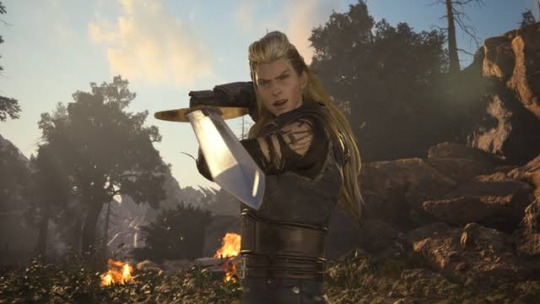
So yeah Roche becomes a Sephiroth Clone. Gets the black cloak and all that.
But... how?
We see 'SC4' for the tattoo and Hojo experiment on him, so that means that he was given S Cells and became a Sephiroth Clone right?
But that's not quite how it works.
Remember Zack was supposed to be a Sephiroth Clone too. But due to being a SOLDIER he wasn't affected by the S Cells and was deemed a failure.
The procedure to become a SOLDIER is said to be more or less the same than the procedure to make a Sephiroth Clone, according to Cloud in FF7 after he remembers his real memories. But yeah SOLDIERS get injected and exposed with mako and Jenova Cells and then the strong become SOLDIERS.
I don't know if it's J Cells or S Cells specifically that gets used in the SOLDIER procedure, but I found this in the wiki and it implies it being S Cells.
*In Junon during Final Fantasy VII the player can talk to an old man in the top floor of a shop who remarks he used to be in SOLDIER. It is unknown what rank or member he was, but later in the game he starts to wear a cape, similar to Sephiroth-clones, stating that he got a sudden urge to dress that way. This hints at SOLDIER members being given Jenova cells as well as mako infusion. In Final Fantasy VII Remake, the kids in the Sector 5 slums mention that the ill robed man that has wandered there used to be a SOLDIER.* -SOLDIER FF7 Wiki.
So I guess if given enough time, SOLDERS become Sephiroth clones, with those with a weaker aptitude for mako and/or Jenova being the first to lose themselves. This being a typical SOLDIER'S type of degradation.
(Angeal and Genesis's degradation is different due to them having G Cells)
But despite Zack being experimented on and probably given a lot of S Cells, he didn't turn into a Sephiroth clone and was unaffected. Hojo himself on the reports says it's due to him being a SOLDIER.
So how I interpret it is that Zack's body has already adapted to the S Cells he already had. Jenova is adaptive and can mutate like that. So when he got more S Cells, the news ones just adapted and copied what the S Cells in his body was already doing instead of what it's supposed to do in a subject that doesn't have pre-existing Cells in them, like the survivors of Nibelheim or Cloud.
Basically the added S Cells are reprogrammed to be like SOLDIER variation and not the puppet Sephiroth Clone variation.
Maybe if Zack lived longer he would of would slowly degradated, but I assume it would of taken years for that to happen.
So how did Roche degrade so quickly and become a Sephiroth Clone?
Well... what did Hojo recently learn?
That Sephiroth Clones and the cells can fuse to create better monsters. And that Cloud is subconsciously heeding the call of Reunion.
What if Hojo is fusing samples together to see if they become more effective?
Roche does have 'SC' on his arm. So S is for Sephiroth and C is for Cloud, that's what I think anyways. (Also if Hojo had some Sephiroth samples he had left in the Manor, then he definitely has some in Midgar. He also probably has samples of Cloud despite him being a failure. It would be bad science to discard it even if it failed.)
And somehow the fusion of both, was able to create a type of Cell that can now degrade SOLDIERS in a manner of days or hours.
(I guess this also ties in that plot line from Crisis Core about Zack's S Cells are worthless, but Cloud's aren't and Genesis needed those Cells to try and fix himself. Remember 'No way he just ate my hair'? Now I'm curious if Cloud's Cells would of actually cured Genesis, or would he of become a Sephiroth Clone? Hmm...)
But yeah...
Not sure if this counts a theory or not.
#ff7#ff7 rebirth#ff7 rebirth spoilers#cloud strife#ff7 cloud#sephiroth ff7#sephiroth#professor hojo#roche ff7#zack fair#theory
72 notes
·
View notes
Text

Master List: ATRU Ch. List
Summary: Time to find out how Joel became a hybrid!
**Warnings: Hybrid science, eventual smut 🔞, medical inaccuracies, a/b/o dynamics, violence, science experiments*

Part Three
"Science without conscience is the soul's perdition." — François Rabelais
“SARAH!” Joel wakes from another nightmare about his daughter Sarah. Panting heavily trying to gain his bearings, the chill of the prison never is a comfort but brings him back to his reality. The fluorescence light buzzes and flickers above, the prison cell contains a metal bed with a thin as hell mattress, small sink w/mirror, and a toilet courtesy of FEDRA’s experiment block. It feels like a prison cell since it once was until FEDRA turned a high security prison into their testing facility. Joel gets up pulling the scratchy blanket off him letting it fall to the cold concrete ground. He moves to the sink and splashes water on his face to get the sweat off. He raises his amber eyes to the mirror glaring at himself. He tries not to look at himself anymore. This version of himself is not one he cares to know. His eyes flick to the scar above his right eye sending himself back to that one day, the day almost as worst as outbreak day.
6 months since Outbreak Day: Near Dallas, Tx QZ
The cities were burning. The quarantine zones weren’t fully safe yet—just hastily assembled barricades, terrified civilians, and soldiers with twitchy fingers. FEDRA was scrambling to hold the country together with guns and duct tape. Anyone not in a uniform was a threat. Anyone who didn’t kneel fast enough was a corpse.
Joel had been drifting— no destination, just motion. Running from grief, from the memory of Sarah’s blood on his hands. Tommy had followed a group named the fireflies. Thinking they could save the world. To Joel there wasn’t a world left to save. He hadn’t eaten in days when he stumbled upon a supply drop close to Dallas–half empty crates, unguarded. Easy pickings. That's when they caught him. He didn’t fight them… at first. He wanted to die, but the soldiers didn’t shoot him. Their orders were to take any civilians they had observed reach the fake supply drop without being detected by infected or other soldiers. They brought him by ambushing him with a syringe to his neck and blunt trauma to his head. The next time he was awake, he was underground–metal walls, cold lights, a former prison turned lab.
A voice greeted him. “You’ve got strong genetics, Subject Twelve. We need men like you–men who survive.”
He learned, through chatter of the soldiers, that the Cordyceps fungus was mutating faster than expected. It wasn’t just infecting people—it was adapting. FEDRA got desperate. They started pushing black-budget science into territory no one talked about before the fall— gene splicing, animal fusion, forced symbiosis. They wanted the perfect soldier, part man, part beast. And they used broken civilians no one would miss. Joel was injected with Variant 1C after four days of “conditioning.” He seized for six straight minutes. His body tried to reject the serum, and nearly did. They did not tell him it was a hybridization program until the first shift nearly tore his insides out. His bones reformed. His senses sharpened. HIs hair and claws sprouted from his skin in violent bursts. The pain was unbearable. This happened for weeks over and over until the serum finally settled with his DNA, the scientist called him a success when he first fully shifted to a hybrid wolf form.
His amber eyes glowed, his teeth razor sharp as were his claws. So was the hunger. He bit through guards, tore through cages. They kept him sedated in those early weeks until he stopped trying to escape. From there he was sent on his first mission. The only solace he found was the little girl he saved that first time out since then there hasn’t been many he could or wanted to save.
Joel comes back to the present realizing he is white knuckling the sink. His amber eyes glowed back at him in the mirror. He scowled at his reflection letting out a low growl. A beeping went off, an announcement started up calling for Subject Twelve to be escorted to testing room two.
🐺🧬🐺🧬🐺🧬🐺🧬🐺🧬🐺🧬
**Thank you for reading!**
#pedro pascal#the last of us#ao3#joel miller fluff#joel miller x female reader#tlou fanfiction#joel miller x you#joel miller age gap#alpha/beta/omega dynamics#tlou fandom#tlou hbo#hybrid#ATRU
7 notes
·
View notes
Text
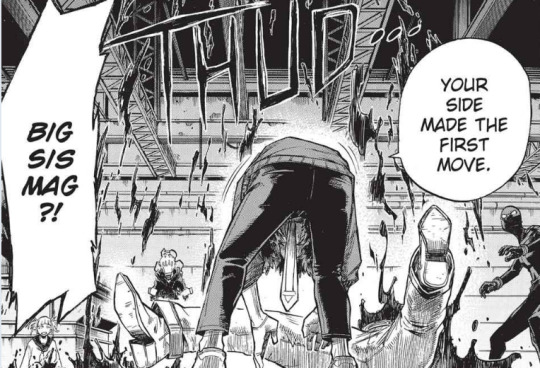
THE OVERHAUL QUIRK.
in essence, it’s destruction and restoration, but it’s not that simple. it would be easy to say “overhaul just changes the cells”, however, it doesn’t quirk work like that. it’s stored in the hands (and the feet, though this is unknown to kai), and can work if any part of his hand comes into contact with an object. note: this headcanon is directly tied to @necrotises, as this overhaul is the origin of their decay.
more under the cut. btw, this can be reblogged and be used for reference by rp partners only.


disassembly: the quirk itself has the ability to manipulate potential energy stored within an object, living or not, transforming it into heat or a kinetic energy at a rapid pace. in the case of overhaul, this transformation happens so rapidly that it must be pushed out with great force, resembling an explosion.
reassembly: it’s a bit more complicated than “overhaul puts the disassembled material back together”. rather, the quirk can pull back affected material, living or not, and reform it into kai’s image.
limitations.
precision: overhaul is not specific enough to splice down to atoms. he can get somewhat specific, but not specific enough to completely change the atomic makeup of an object. the object will always have qualities of its original form. that said, chisaki will do your transgender operations! (its reparations for accidentally misgendering magne. sorry mag. his bad.) he did his own top surgery, and opted to leave almost fishbone looking scars.
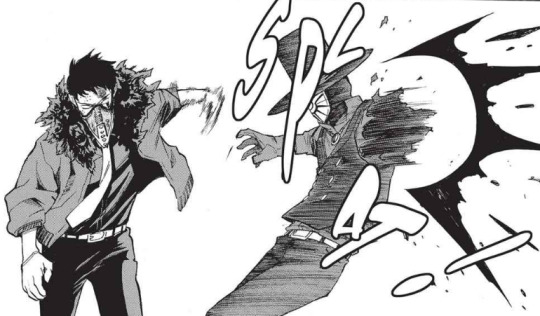
timeframe: reassembly can only occur for up to 15 minutes after disassembly. otherwise the ability to pull back the affected material is altered. were he to try reassemble after that time period, the object would need to be disassembled and reassembled once more.
two-halves: disassembly is possible without reassembly, but not the reverse. if chisaki is not intending to reassemble, the energy must be released. as we see in magne, compress, and that one hassaikai babysitter, we see the “explosion” mentioned earlier. blood is splattered everywhere, and a mess is made. this is inevitable. were he to do this to another object, it would react similarly.


specifics.
restoration: kai can decide how much of a person is reassembled, but this takes concentration to adjust to an imperfect level. the quirk naturally seeks to reassemble to a near-perfect level. it’s likely that if an ally is ressembled, they will find all cavities and minor injuries completely healed. this may also happen if he’s in a rush, or looking to display his power.
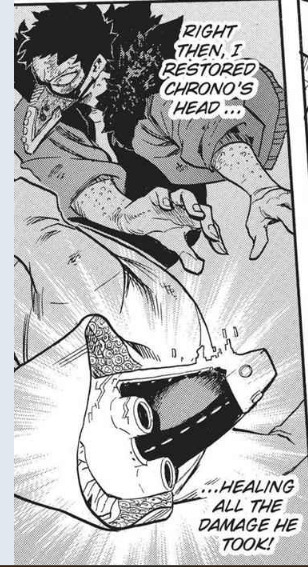

fusions: quick note here, kai can use overhaul through someone else’s hands, but only if they are fused to his body. there’s no magic possessing or anything. he must have the hands fused to his body in order for it to work. back to the main point. kai can fuse any two objects together, including himself, though it is not necessary.
fusing himself: kai will always remain the dominant consciousness if he’s fusing with another human. the other will be in a dream-like state, and likely will have blurry memories of the events once split. additionally, he can use the quirks of others once fused, as we see with nemoto.
fusing others: whichever will be the dominant consciousness is a gamble. he can’t decide that; it’ll be something of a battle between the minds being fused. and because of that, fusing two humans is a risk. chisaki can fuse more than two beings together, but the consciousness situation becomes more tricky after that, so he prefers to only fuse two, or fuse with himself.

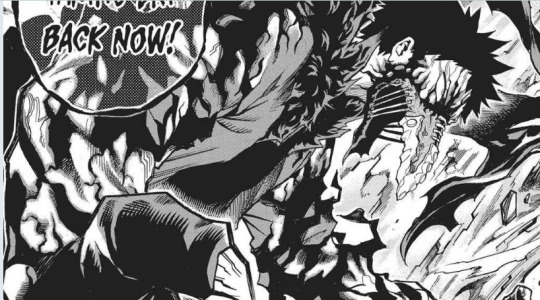
stability: overhaul is an unstable quirk. anything may accidentally be overhauled when the gloves are off. should chisaki experience heightened emotional stress or external stimuli, he has little control over what gets overhauled. he has no issues immediately overhauling whatever puts him under such intense stress, so be mindful of staying in his good graces. additionally, many pillows and bedsheets have been overhauled during times of intimacy and ecstasy. the quirk itself was more unstable when he was younger, which the gloves helped. on top of this, he trained to keep himself calm in most situations, but it’s still a gamble when the gloves metaphorically (and physically) come off.

experience.
disassembling: being disassembled, though it seems like the most painful part, is actually the calm before the storm. it’s quick, and not the worst pain anyone is likely to feel. its uncomfortable, of course, as any manipulation of energy in the body would be. there is a warmth as the body part “explodes”, but as mentioned above, it’s so incredibly quick. the victim might not even know they were disassembled.
reassembling: this is where all the pain that should've been experienced in the disassembling stage catches up to the victim. as nerves are rebuilt, the pain from the disassembling is finally felt, leaving the victim in genuine agony, even for those with high pain tolerances.
those being reassembled can expect to experience:
mind-altering pain. the inability to speak or stand. they may also experience temporary amnesia.
extreme psychological distress. possible delusions/hallucinations from the pain.
physical symptoms. nausea, vomiting, heart palpitations, sweating, muscle spasms, and more.
chronic symptoms will include:
common ptsd symptoms. depression, anxiety, paranoia, nightmares, flashbacks.
phantom pains, despite the body being restored.
upgrades.
atom-splicing: were overhaul to upgrade this quirk, he would likely be able to splice things down to the atom . this would allow him to split quirks from owners, change the entire makeup of something, and so on.
contact: another potential upgrade would be the ability to overhaul something from not just his hands nor feet. rather, his arm or leg could brush against something and change it.
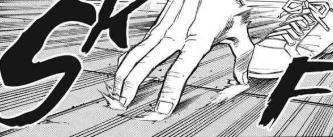
overhaul and chisaki.
the quirk takes little from him. while some quirks come at the cost of stamina or concentration, overhaul doesn’t ask much from kai. he doesn’t need to know the makeup of something to restore it, nor does it take time for him to overhaul an object or person. the process happens in seconds. he attends medical school in order to get a better understanding of anatomy for his ultimate goal, though this knowledge helps him adjust the level of reassembly.
it has little psychological effect on him, and the only thing he “feels” when overhauling is moderate heat in his hands from the energy transfer. he does experience the same pain as a victim would when he overhauls himself. he trained to handle the pain and work through it quickly, but he still remarks it as unpleasant.
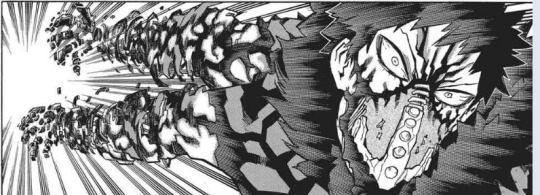
conclusion.
overhaul is an incredibly powerful quirk that certainly should’ve earned more than a “b-rank” in ultra analysis. it’s ultimately unstable, though chisaki has trained for the amount of control he has currently. it has many different applications, though the symptoms and side effects of being overhauled are intense.
#META.#hiiii.#overhaul is so op and one of the coolest quirks#i had to talk about#also isa was a massive help on this meta creation#and yeah let him to your gender affirming surgeries :)#its quick :) dw about the emotional issues after :)#writing soon! getting more comfy here! rahh!
16 notes
·
View notes
Text
Hmm, I am looking through endless Ultimania translations to find a bit of information on a Crisis Core scene that will help me finish a post but as usual I became distracted.
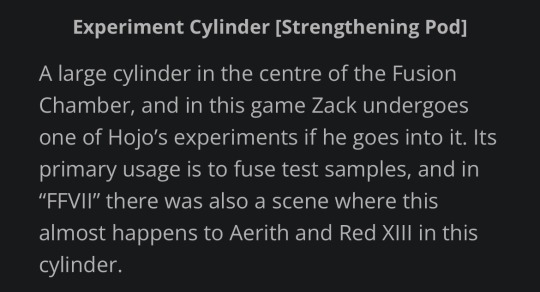
(From the Crisis Core guide).
I was thinking about this fusion pod that Hojo lets Zack enter. Hojo can also apparently use it to physically enhance subjects?

Somehow Zack is infused to become stronger and then….
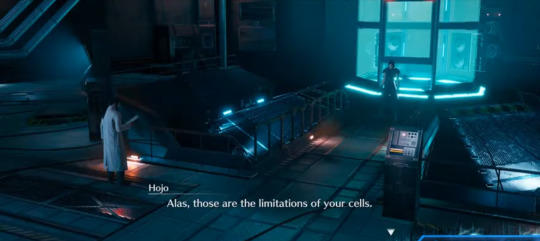
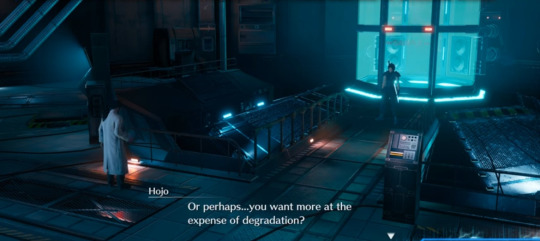
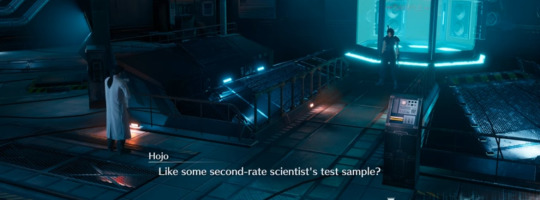
Hmmm.
Too much enhancement leads to degradation for SOLDIERs.
Alas, they all have their limits.
Well. Except one…
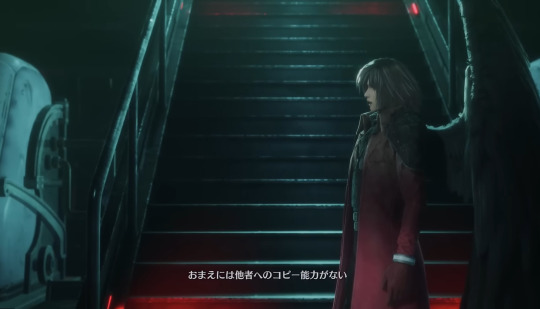

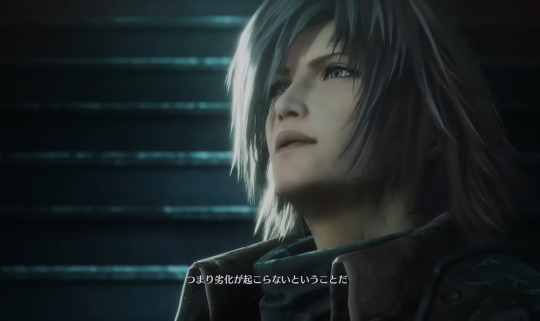
“You do not have the ability to copy unto others. Your DNA cannot be spread. Thus your body cannot deteriorate.”
Sephiroth’s cells have no limitations. How proud Hojo must have been, to discover that his first-rate science experiment, could not degrade or reach the limit of his cells.
He could enhance Sephiroth endlessly, making him stronger and stronger. Always superior to Hollander’s experiments. Never reaching a limit to what Project S could endure.
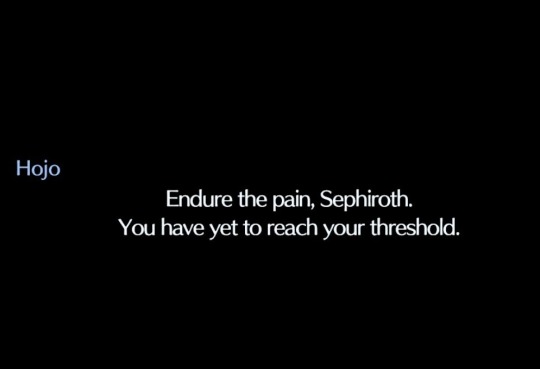

There was no threshold, was there?
#uff#i also read again that hojo won jurisdiction over the science department because he proved project s was superior#to project g#sephiroth was pitted against angeal and genesis even when they were still infants#i am like sephiroth looking through the data room 😂#trying to understand everything#ff7#final fantasy 7#sephiroth#genesis rhapsodos#crisis core#hojo#fvii crisis core#ffvii#zack fair
83 notes
·
View notes
Text
Meet The OC: Bec Querel
This is an explanatory writeup of one of my Original Characters (OCs). Nothing here is necessarily related to a meaningful fiction you should recognise and is shared because I think my OCs are cool and it’s cool to talk about OCs you make.
Bec Querel lived the life – such as it was – of every child genius. Attaining truly prodigious achievement before adolesence, she burst onto the scene of national significance as a child prodigy and mutant, and just as quickly faded once it was realised that she wasn’t going to do anything of particular noteworthy significance compared to the latest celebrity starlet inclined to lose her underpants in public.
Furthermore, Bec realised that she was in possession of knowledge and understanding that was well beyond her means to communicate. Without a solid social grounding – she had blurred her way through her schooling in pursuit of more knowledge – she had realised she lacked a mature communication base. While in this state, she was approached by Dr Marion Shepherd of Project Corona, and asked to rejoin the project.
Seeing an opportunity to expand her skill base, and to perhaps use her mathematically-refined powers for some good, Bec agreed, and began her two-year journey through high school once more.
Bec Querel is a genius. She’ll tell you as much, but only if you ask. It’s not something she feels the need to volunteer, because that isn’t a thing that Ordinary And Reasonably Standardised experiences involve. An insufferable child genius she has resolved to redo her adolescent education to pursue not an optimal path through to maximised resources and instead stabilising social experiences that result in her not being a potentially Morally Ambiguous Doctorate Scientist (M.a.D).
Bec Querel is a living star, her biology somehow managing to overcome the herculean task of room-temperature fusion. She absorbs solar energy and emits heat, and her body operates like a nuclear furnace. Many of her internal organs are nonfunctional or vestigial, and her digestive tract is almost ornamental [citation needed]. Her body sustains itself through a superefficient permutation of breathing – as long as she has oxygen and carbon atoms to access, she can continue generating energy. Further, her cells emit most of their waste in the form of low-key emittant radiation, which she can focus into concentrated bursts and blasts.
As a hero, as an ally, she is a point of blatant utility. Since her mutation is effectively a nuclear fusion energy battery inside her own body, she is capable of powering some truly ludicrous devices, and uses that energy to drive devices that would otherwise be untenable to use in combat scenarios. It’s all very good to have a flash-vaporiser that can knock people unconscious by dehydrating them for an instant or overloading their optic nerves, but unless you can power that kind of device repeatedly, it’s not going to be useful in most active conflict environments. Bec is the power supply, and everything else she does is filtered through those tools. This even includes the imps that follow her around, three small fire goblins that she keeps contained with an electrically-powered rune portal to give them freedom to hang around her.
Bec’s powers are ultimately limited in their finesse. She wields radiation the same way one might wield a club, and lacking any good visual metaphor for the practice, she instead has to rely on fine-tuned processes and mathematical formulas that need adjustment on the fly. With this in mind, rather than causing irreperable harm, she has to keep her radiation tools somewhat inexact and imprecise – reducing people’s reaction times and making them feel nauseated is often the limits of her radiant prowess. Further to that, her ability to use heat and light to blind and confuse enemies are fairly two-dimensional in their applications, meaning that most enemies who come prepared can best them, usually with heavy optic shielding.
Finally, Bec may be a genius but that doesn’t make her cunning; her ability to outwit enemies often relies on an understanding of what they would or should do, and her lack of social familiarity with most social strata means that she’s not very good at predicting the sensible behaviour of even normal street gangs. All her theories work just fine, for spherical villains in a vacuum.
Mechanics
Bec was a fire control/radiation emission controller.
I don’t have a current build for her and really, if I did have a copy of her build to open it I’d first need to find an earlier version of Mids, open it in that, then export that build to a current version and daisy chain the build to curent Homecoming standards.
If I was building her today, I would deliberately be trying to give her a build that hit the goal of:
Permanent Accelerate Metabolism. This is doable around 130-140% global recharge, with Hasten, and then feeds into it. This would necessitate two ‘auto’ buttons – which I’d get by binding hasten to my ‘back’ button, a trick I’ve been doing on almost all characters these days.
A single-target attack chain of (probably) Char + An Epic Attack + Ring Of Fire, and a ranged aoe fireball effect. Treating these as attacks before controls is a bit risky, but remember that this is a character with a ludicrous amount of recharge; single target holds lasting a long time isn’t that important because she’d be attacking with it every few minutes.
I’d have to choose between using Hot Feet and standing near people to do more area damage and control, versus flying around at range and relying on ranged defense to protect her from mezzes and damage. The former wants Smashing/Lethal defense, the latter wants Ranged defense and resistance armours. This could hinge on how endurance-hungry her build is. If she’s an end hog, turning off Hot Feet and relying instead on resistance armours could play into Cardiac.
If I was building her today, I probably wouldn’t spare any expense. This is an old, beloved character with a very fun playstyle and a beloved characterisation. If I could get her friends back into the game, or even make comparative friends, there would be in my mind, no problem with literally bankrolling everyone to have fancy builds like hers.
Of course, that won’t happen, but it’s still a thing to think about. I still have this character occupying my headspace after all.
History
That is the description I wrote for Bec Querel, sometime before January 2010, and Bec herself was made in 2007. This is at least 15 year old writing. It is, in my opinion, weak, and part of what makes it weak is that it tells you a backstory at the expense of the character you’re going to interact with.
Bec Querel is an autistic supergenius nuclear astroscientist who noticed she was lonely at the age of 15 and decided to re-do highschool as an Optimal Social Experience. She did this because she did all the super-science she needed to do and now she wants friends, and she’s bad at having them. To do this, and not give up on the super science, she took on the task of a High School Hero (which I would, now, probably position at college rather than high school).
I don’t think I even have Bec Querel’s name camped anywhere now. It seemed to me to be one of those free, perfect versions of its name; a character who cared about temperature and radiation, where the unit for measuring those things was itself, also pretty believable as a name? I think it’s clear in my mind that she was a Rebecca, and therefore Bec, and maybe even had some degree of a semi-public identity (when she was publishing academically), that she turned into a private identity by inventing a fake surname for her hero identity. Papers that were published at first pseudonymously because of her age and then declared connected to a superhero identity strike me as a thing for her.
Ultimately, the history of Bec Querel is a tangle because she was one of my important milestones of a character. She was almost my first hero 50; she was easily one of my highest level heroes as I played her in a dedicated team, even if I wasn’t good at it. Bec was my introduction to the Virtue roleplaying server and becoming part of that roleplaying public space. Also, and this is important: Bec is defined in my memory by disappointing other roleplayers by being a butthole.
Also, Bec is a character whose sexuality I had to work out. I’m still not sure where she lands, but for a while there she was genuinely curious as to if she had a sexuality or not.
Oh! And she’s where I first used keybinds to do something impressive (in her case, singing all of ‘O Canada’ one line at a time). I’ve since become very familiar with the keybind system and now I like doing specific things to squeeze function out of the interface.
Conclusion
I miss what Bec was about. I miss the friends I had with her. I wish I’d been better at being a friend and I wish I’d been better at talking with people about what they needed and how they were feeling. I wish I’d been better at talking about what I felt.
Like I dunno, maybe I was specifically, kinda trash at being a good friend because of a hole blown in my high school life.
Check it out on PRESS.exe to see it with images and links!
12 notes
·
View notes
Text
Operation F.A.L.L.E.N
FRACTION OF THE WORLD- PRT.4
The Forgotten War Survivors (Adult Villain Factions)
Also Known As: The Adult Underground, The Elders, The Remnants, The Old World Scars
Motto (Rumored): “We remember when the world made sense.”
True Motto (Spoken in Code): “No child should rule unchecked.”
Overview:
When the original KND campaigns drove adults underground, many thought the war was over. But after the Great Collapse and rise of the Citadel regime, the few surviving adult villains found renewed purpose in a world gone feral. No longer cartoonish or bumbling, they now command scavenger cults, rogue militia bands, or cling to shattered cities where the memory of the "Old World" is their most potent weapon. Some seek revenge for past defeats, others crave a return to the old order, but none trust the new KND. While the regime publicly claims they “eradicated all adult threats,” several formidable factions remain, and their influence grows in the wastelands. Whether they act as outright enemies of the KND or forge dangerous, fleeting alliances with the rebellion, these remnants of childhood’s greatest fears now haunt the future the KND claims to protect.
Leadership:
Father – “The Ember King,” The Architect of Ashes: The nightmare behind the Delightful Children from Down the Lane, Father is now the undisputed patriarch of the Forgotten War Survivors. His once pristine mansion is a burned-out husk, but his power remains terrifyingly intact. He rules the Ashmouth Enclave, a grim, industrial zone built from a shattered city of ash and glass, where abandoned KND tech and his own twisted Delightful experiments power his hellish operations. His body, burned and cracked, is held together by fusion residue, and he walks with a cane that doubles as a searing flame cannon. A myth to some, a boogeyman to others, he is known for burning entire KND scouting teams alive, leaving only charred silhouettes and melted comms. Father secretly seeks a weapon to "delightify" the Citadel—turning Rachel’s elite into his own soulless puppets. His cold, calculating intellect and a temper that can literally ignite the air make him the most dangerous of the adult remnants.
Structure:
The Ashmouth Enclave: Father's direct, cult-like following. They are fanatically loyal, clad in dark, ash-dusted robes, and responsible for maintaining his twisted machinery and enforcing his will across his territories. Many were once "delightified" children or desperate adults seeking a semblance of order.
Independent Cells: The other adult villain groups largely operate as autonomous entities, forming temporary, self-serving alliances or grudges based on shifting power dynamics and resource needs. Father exerts influence through fear, offers of powerful salvaged tech, or simply by being the strongest predator in the wastes.
The Collectors: Covert agents who scour the ruins for pre-Collapse technology, forgotten KND blueprints, or anything that can be repurposed to fuel the adult's fight against the new world order. They often clash with KND salvage teams.
Territories Controlled:
The Forgotten War Survivors hold sway over distinct and often unsettling territories across the ruined landscape. Father's primary domain is the Ashmouth Enclave, centered around the industrial ruins of a former metropolitan area. This grim expanse is now a wasteland of perpetual smog and glowing embers, notorious for its dangerous factories and hidden laboratories where dark experiments fester. Meanwhile, Knightbrace's Orthodentist Clans meticulously control the Dental Labyrinths, a sprawling network of subterranean tunnels and fortresses beneath former urban centers. These unsettling spaces are kept unnaturally clean, serving as bases for his mobile surgical units. Along the coasts, Stickybeard's candy-fueled pirate fleet protects The Candied Isles, a series of interconnected, fortified islands and floating shanty towns crafted from salvaged ships and debris, often found in flooded regions. Deep beneath major cities, The Toiletnator's "Waste Cult" has repurposed The Deep Cisterns, vast, decaying sewer systems and underground water treatment plants, as their operational base and prime ambush points. Finally, Grandma Stuffum's "Gut Cult" occupies The Overstuffed Bunkers, isolated and heavily fortified structures often disguised as abandoned farmhouses or industrial warehouses, serving as chilling feeding grounds and indoctrination centers.
Public Image:
Among the Citadel Citizens: The Eradicated Threat: The KND regime publicly claims all adult villains were completely vanquished during the Great War, their names scrubbed from official records and their existence denied. This narrative of total victory reinforces KND control and demonizes any whispers of adult resurgence as "dangerous propaganda."
Among the Wasteland: The Boogeymen and the Bargainers: To the scattered freefolk and the younger generation in the wastes, the adult villains are figures of both terror and desperate opportunity. They are the boogeymen of old stories, but also potential, dangerous allies for those desperate enough. Tales of their cruelty are common, but so are whispers of salvaged food or tech that can be acquired, usually at a terrible price.
Technology & Weapons
The Forgotten War Survivors' arsenal is a chilling blend of old-world ingenuity and post-Collapse desperation. Father's creations, like the Charred Core Cannons (once industrial furnaces repurposed as heavy artillery) and his Delightfulizer Mk. II (a more potent, unstable version of his original weapon, capable of mass "delightification"), are among the most feared. Knightbrace's Orthodontic Drills have been upscaled into brutal, high-speed cutting tools, while his Brace Drones are now unsettling airborne units that can implant mind-controlling devices. Stickybeard's Gummy Grenades explode with corrosive, sticky sugar compounds, and his ships are powered by volatile Molasses Engines. The Toiletnator's Plunger Cannons fire high-pressure streams of toxic sludge, and his Sewer Skiffs allow rapid, unseen traversal of the underground. Grandma Stuffum's Gastro-Guns launch dense, explosive goop, and her cult often utilizes modified kitchen appliances as gruesome, unexpected traps. All their technology reflects their desperate ingenuity and their twisted understanding of how to inflict misery.
Notable Members
Father – “The Ember King,” The Architect of Ashes: (See Leadership section above for full description.)
The Delightful Children From Down The Lane – “The Perfected Ones,” Father’s Heirs: Once the pinnacle of childhood perfection, these five children are now Father’s chillingly loyal enforcers and the supposed heirs to his villainous kingdom. Stripped of their individuality and imbued with collective, cold precision, they operate as Father’s ultimate weapon and his personal guard within the Ashmouth Enclave. They execute his will without question, their synchronized attacks and unsettlingly blank expressions a stark reminder of their "delightified" state. They are the living embodiment of Father's twisted vision for the world.
Knightbrace – “The Ivory Tyrant,” The Orthodontic Zealot: The fanatical leader of the Orthodentist Clans, obsessed with imposing rigid "order" through painful dental modifications and obedience drills. He sees the chaos of the wastes as a giant malocclusion, needing his brutal correction.
Stickybeard – “The Sugar Baron,” The Confectionary Kingpin: A former pirate captain now ruling over a vast, illegal candy empire from his floating Candied Isles. He trades in highly addictive, sugar-based narcotics, manipulating loyalty and labor through sweet, destructive cravings.
The Toiletnator – “The Waste King,” The Sewer Sovereign: Once a bumbling joke, now the deranged but dangerous ruler of the vast, decaying sewer systems beneath the old cities. He commands a cult of followers who believe the world was "flushed" by the KND, and he alone is left to clean it up with corrosive waste bombs.
Grandma Stuffum – “The Feeder,” The Devouring Matriarch: The warped matriarch of the "Gut Cult," operating from isolated bunkers. She believes hunger is the ultimate enemy and force-feeds her malnourished, brainwashed followers and captives, transforming them into bloated, subservient drones.
Enemies od the Clan:
The Iron Clad (The New KND Regime): Their ultimate and historical enemy. The adult villains resent the KND's current dominance and the suppression of adult influence, viewing Rachel McKenzie's regime as an abomination that usurped their rightful place. They dream of dismantling the KND and reclaiming control of the world.
The Broken Tooth Rebellion: Generally seen as an annoying, idealistic nuisance, or sometimes a potential, temporary tool. While both groups oppose the Iron Cradle, the adult villains harbor deep mistrust for any child-led resistance and typically view them as naive obstacles, prone to emotional decisions. Alliances are rare and strictly transactional, built on mutual self-interest rather than shared ideals.
The Raiders Clan (Cree's Group): A chaotic and unpredictable threat. The adult villains find the Raiders' lawless nature and destructive tendencies inconvenient to their own operations. While very rare, desperate circumstances might force temporary truces for mutual survival or to eliminate a common KND threat, but deep-seated animosity and territorial disputes are common.
Faction Comparison
Father's Enclave: Like Fallout’s Caesar’s Legion crossed with the Fire Nation ruins—religious, fire-worshipping, ritualistic, and utterly ruthless.
Knightbrace: A fascist dentist-priest cult; imagine an Orwellian body horror with a forced, gleaming smile.
Stickybeard: A pirate warlord meets a drug cartel kingpin, controlling illicit trade with a sugary grip.
The Toiletnator: An eco-terrorist warlord with a severe grudge, commanding a labyrinthine, unsanitary domain.
Grandma Stuffum: A twisted Matriarch—part Mother Gothel, part Hannibal Lecter, whose "love" is a form of horrifying control.
#codename knd#knd#knd au#codename kids next door au#operation F.A.L.L.E.N#planning au#new project#au in progress#au info
9 notes
·
View notes
Note
I saw your post abt Arceus' biblically accurate angel true form and I feel that! I feel that!! In my writing I decided that Arceus' true form is extremely hard to look at and more of a series of impressions than a true perceivable object. Like when it was pleased they got hit with an image of way too many teeth.
And just standing before it with its attention feels like every eye in existence is watching them
In my brain I kinda pictured Arceus being a little like Coyote in the Ether from Gunnerkrigg Court; incomprehensible to the human brain

One of my fav other concepts is the double Arceus fusion that looks a bit like the beta design

(sprite by ralliv for the infinite fusions hack)
I do feel like there's diff ways you could take it than the biblically accurate angel approach
Sorry for taking so long to answer-- truth is i just didn't know how to respond WHEEZE
I'm.. Super picky about how I wanna handle Arceus and that's on me! The Beta Arceus trend wasn't my cup of tea either! ^^'
I guess in my opinion, Arceus's true form is... For me, just energy? Like the whole reason it can become different colors and change to all types and has a move that changes to all types is because Arceus is the Power of Pokemon taken form.
But it is in the same vein. Space and Time and Anti-Matter are abstract thoughts that don't ever really have a defined shaped THING we can touch. So the dragons are just symbolic of those concepts.
I think I just like that Arceus is as it is. No extra super secret ultimate eye melting form that no one can comprehend.. But it is as incomprehensible as like... You and I! Existing!
Existence is a funny and scary thing to think about. Why this body? Why am I a human and not some other animal? Why am I on this specific planet? Everyday we experience and form an identity and adapt and change...
And I suppose Arceus is the same. All these electrons. Neurons. Fur. Energy. Particles and skin-- Are we even a solid mass or a bunch of atoms holding hands, determined by chemical hormones?
Energy is weird. Energy is even WEIRDER when it speaks and talks and types on a computer. We become bored of Arceus's form that we think it must have this existential amazing cosmic self that is hidden from us...
And yet. In its titular game, it stays the same. It is Arceus, and it has plates, and it wants to befriend a human after having a tough, climatic battle. It is a bunch of energy and cells and atoms barely linked together by electricity. It is a great, fuzzy being capable of love, just like you and me.
14 notes
·
View notes
Text
Five Kluft Observations I Can Get Behind
The Phenomenology and Treatment of Extremely Complex Multiple Personality Disorder is my favorite Kluft paper. It says a lot of things I don’t like, that make me cringe and that I would describe as poor interpretations of good data given half a chance.
I don’t like Kluft’s vibe, because I feel as though my existence is being viewed cynically and coldly while I stand behind a glass screen, also known as my cell phone. This paper has a good number of points that I argue regularly, and everybody who’s done their homework on DID knows Kluft. Reliable, if not my choice for best person ever.
Number one: self-diagnosis
While not exactly how the term is modernly used, these complex systems were aware they were systems prior to diagnosis.

Number two: good splitting
Ego-syntonic splitting, which, while vague, speaks for itself. They are in line with the needs and wants of the self and are neutral to positive experiences. Table 1, that whole list, in all of its controversy, is beautiful to me.

Number three: innerworlds
Also vague, but alluding to the kind of innerworlds described online presently. I believe it’s Ross whose articles describe the connection between immersive (specifically maladaptive) daydreaming and complex (specifically CDD/DID) systems, but both could be taken as evidence that immersive internal worlds are recognized by professionals.

Number four: not pie
If we are the equivalent of a singlet collectively, each alter in a large dissociative system gets only a tiny slice of personhood. Sometimes that fits, with alters who are fragmented beyond Braun’s defined personalities, but there are cases where it doesn’t.

Number five: multiplicity
This describes what I’ve been trying to say the Theory of Structural Dissociation (or at least the Haunted Self) is missing. The next step of we’re not pie. We are the pieces that worked shoved into a new vessel, the behaviors we needed but couldn’t keep as one, a shifting sand of every moment of our history and everything we learned and had before. This is my system, or the dissociative bits of it, recognized. From a guy who finds us underqualified to count as personalities.

Again, I don’t agree with Kluft often. I feel belittled and set aside in my own treatment despite him not being my clinician. But it’s like a balloon inflating in my chest to see so much of online discourse addressed academically. I think this paper is one of the, if not the, most commonly cited sources for fictional introjects, and it mentions restructuring alters to fit those roles after they form.
It still pushes fusion real hard. It still frames multiplicity as failure. But it sees us.
The last one (not about fictives) is most important to me. We’re really multiple like that, even if the same article negates it. This is the philosophy that we build our personhood on, and the other is semantics. Kluft sees us.
#now if he’d close his eyes#I need the documentation but I don’t like it#osddid#cdd system#cdd inclusivity#multiplicity#mpd
9 notes
·
View notes